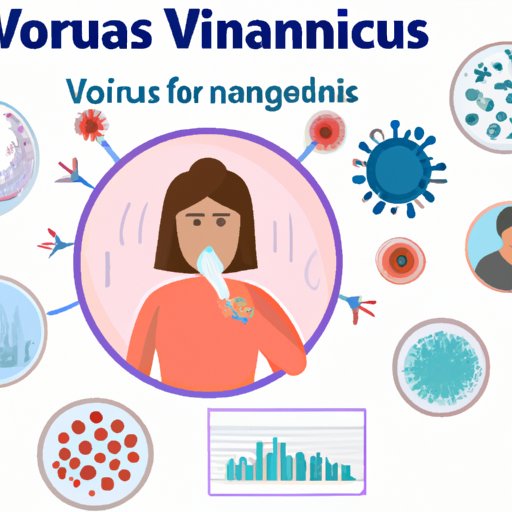
Introduction
Being sick is never fun, but it can be especially frustrating when you’re not sure if you’re still contagious. Understanding how long various illnesses are contagious can be challenging, but it’s an important part of managing the spread of illness and keeping yourself and others safe. In this article, we’ll explore the science behind being contagious, break down the contagious timeline for common illnesses, and offer tips for protecting yourself and others.
Understanding the Science: How Long Are You Contagious For?
At their most basic level, viruses are tiny particles that infect cells in our bodies and make copies of themselves. They can spread from person to person through various means, such as coughing or sneezing, touching surfaces contaminated with the virus, or being in close contact with someone who is infected.
The contagious period for different illnesses can vary based on factors such as the type of virus, the severity of symptoms, and the individual’s immune system. Some viruses are contagious for a longer period than others, and some people may be contagious even if they are showing no symptoms. Understanding contagiousness is vital to slowing the spread of illness and protecting our communities.
Breaking Down the Timeline: A Guide to Contagiousness
The timeline of viral replication in the body can vary depending on the type of illness, but generally, as the virus multiplies in the body, the individual becomes more contagious. The contagious period typically begins before symptoms appear and may last for several days or even weeks after the individual begins to feel better.
For example, with the common cold, individuals are typically contagious for the first three days after symptoms start. With the flu, individuals can be contagious for up to a week after symptoms begin. In some cases, such as with COVID-19, individuals may be contagious for even longer periods.
Containing the Spread: What You Need to Know About Contagiousness
The most common ways viruses spread are through respiratory droplets and contact with contaminated surfaces. It’s essential to take precautions such as washing your hands regularly, avoiding close contact with sick individuals, and wearing a mask to reduce the spread of illness. Additionally, getting vaccinated against certain illnesses such as the flu can help reduce contagiousness, even if you do become infected.
The Biggest Misconceptions About Being Contagious
Many misconceptions surround being contagious, which can create confusion and even contribute to the spread of illness. For example, some people believe that being asymptomatic means they can’t spread the illness, but that’s not always the case. Understanding how viruses spread and how contagiousness works is critical to protect yourself and others from illness.
Protecting Yourself and Others: How to Manage Your Contagiousness
Preventing the spread of illness starts with taking basic precautions such as washing your hands regularly, covering your mouth and nose when coughing or sneezing, and avoiding close contact with sick individuals. If you’re experiencing symptoms or know that you’ve been exposed to someone with an illness, stay home and seek medical attention if necessary. Additionally, consider getting vaccinated to protect yourself and others.
If you do become infected with an illness, it’s essential to take steps to reduce the spread. Wear a mask, isolate yourself from others, wash your hands regularly, and avoid touching your face. Follow the guidance of medical professionals and public health authorities to manage your illness safely and reduce the spread.
The Role of Testing in Determining Contagiousness
Testing plays a critical role in determining contagiousness, particularly with illnesses such as COVID-19. Tests can determine if an individual is currently infected with a virus, and in some cases, how contagious they are likely to be. If you suspect you’ve been exposed to an illness, seek medical attention and follow the guidance of medical professionals on testing.
Taking Action: What to Do When You Know You’re Contagious
If you become aware that you’re contagious, take steps to reduce the spread of illness. Stay home if possible, wear a mask when interacting with others, and avoid close contact. Follow the guidance of medical professionals and public health authorities to manage your illness safely. It’s essential to inform anyone you’ve been in close contact with recently to inform them that they may have been exposed to an illness.
Conclusion
Understanding the contagious period for different illnesses and how to manage your contagiousness is crucial to protecting yourself and others from illness. Basic preventive measures such as washing your hands regularly, wearing a mask, and staying home when sick can go a long way in preventing the spread of illness. Remember, we all have a role to play in reducing the spread of disease, so take action to protect yourself and those around you.




